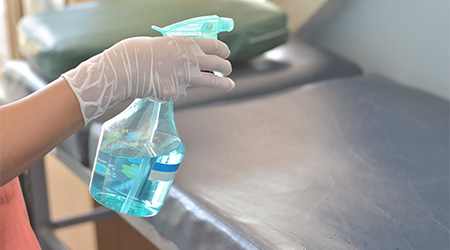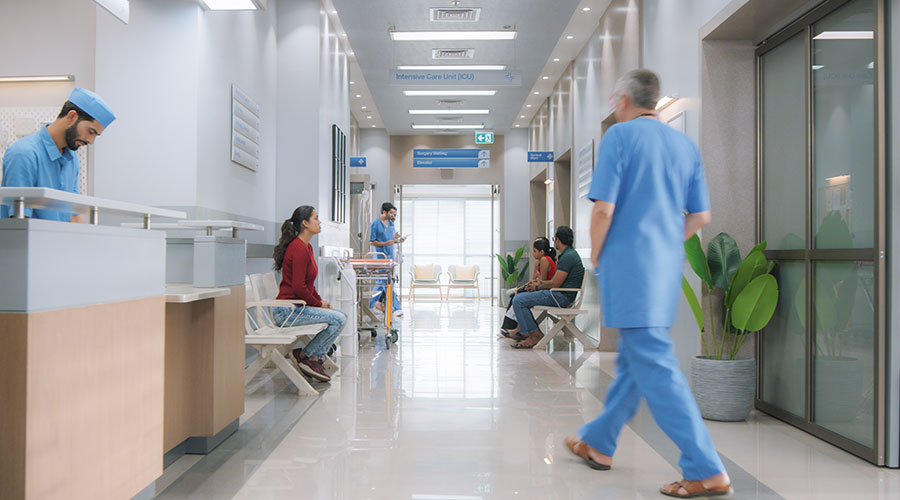The U.S. Centers for Disease Control and Prevention (CDC) inspects cruise ships for sanitation, but it does not inspect hospitals. In hospitals, a pathogen will persist in an appropriate environmental niche unless removed through hygienic cleaning. If abandoned, it might contaminate hands or be uplifted among dust by air currents and deposited onto a patient or surfaces near the patient.
Hospitals once tested surfaces for bacteria, but in 1970, the CDC and the American Hospital Association advised them to stop, declaring testing was unnecessary and not cost-effective. MRSA infections since then have increased 50-fold, and numerous studies have linked unclean hospital equipment and rooms to infections.
But the CDC's latest guidelines still deem routine testing for bacteria unnecessary. Their rationale is, “If you culture on a regular basis, you're always going to find something. You don't want the medical labs to be used for that instead of tests on patients."
The Joint Commission
One would think that a hospital accredited by the Joint Commission is clean, but that is no guarantee. State hospital inspectors investigating complaints from the public found that nearly one-quarter of hospitals where conditions were unsanitary had been inspected and accredited by the Joint Commission within the previous year.
At the hospital where I was working in 2014, we had a four-day triennial survey by The Joint Commission. In the debrief with the hospital leadership team, the Joint Commission survey team was highly complimentary of the level of cleanliness in the hospital. In fact, one of the surveyors said, “I’ve surveyed hospitals that weren’t as clean as this one. When I retired to my hotel room at the end of the day after being around dirty surfaces, I prayed, ‘Lord, don’t let me get sick and have to go to that hospital.’”
Fitness for purpose
If hygiene procedures are to be effective, a determination needs to be made regarding not only product efficacy but more importantly, whether the process produces the results we want to achieve — namely, hands, environmental surfaces, fabrics, etc., that are hygienically clean — fit for purpose — and sufficient to break the chain of infection transmission.
When it comes to professionally cleaning surfaces, we need to get rid of the term “clean when visibly soiled.” Increasingly, the data show that potentially unsafe levels of pathogens can remain on visibly clean surfaces. Fecal matter the size of a pinhead contains sufficient infective material to transmit C-diff.
When your staff is given the instruction to clean visibly soiled touchpoint surfaces, are they looking for soil the size of a pinhead? No. That is why managers should eliminate that term from education, training, policies and procedures.
Managers need to make it clear that in hygiene practice, a surface can only be judged as safe if it has been subjected to a validated hygiene process that has been carried out in the prescribed manner. Visible cleanliness alone is not sufficient to judge whether a surface is safe.
Having no knowledge of an accepted risk-based standard to verify that a hospital is truly safe and clean, I am advocating for one. Will you join me?
J. Darrel Hicks, BA, MESRE, CHESP, Certificate of Mastery in Infection Prevention is the Past President of the Healthcare Surfaces Institute. Hicks is nationally recognized as a subject matter expert in infection prevention and control as it relates to cleaning. He is the owner/principal of Safe, Clean and Disinfected. His enterprise specializes in B2B consulting, webinar presentations, seminars and facility consulting services related to cleaning and disinfection. Learn more at www.darrelhicks.com.

 Case Study: How NYU Langone Rebuilt for Resilience After Superstorm Sandy
Case Study: How NYU Langone Rebuilt for Resilience After Superstorm Sandy Frederick Health Hospital Faces 5 Lawsuits Following Ransomware Attack
Frederick Health Hospital Faces 5 Lawsuits Following Ransomware Attack Arkansas Methodist Medical Center and Baptist Memorial Health Care to Merge
Arkansas Methodist Medical Center and Baptist Memorial Health Care to Merge Ground Broken on Intermountain Saratoga Springs Multi-Specialty Clinic
Ground Broken on Intermountain Saratoga Springs Multi-Specialty Clinic Electrical Fire Tests Resilience of Massachusetts Hospital
Electrical Fire Tests Resilience of Massachusetts Hospital